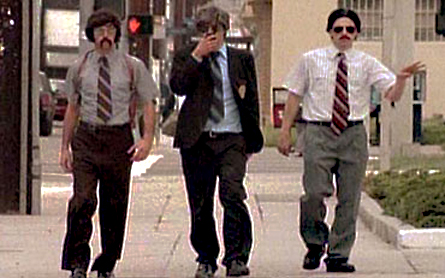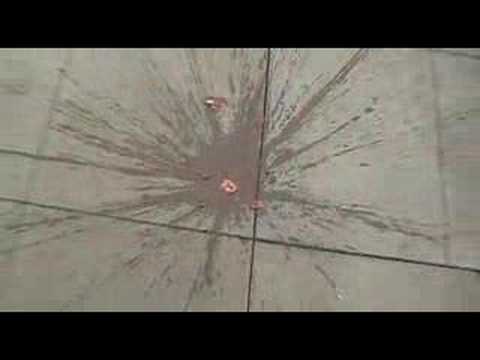Canberra’s cute enough; really boring on weekends, even if Elvis Costello is playing in a park. In the late 19th century the Australians decided they needed a federal capital, and eventually picked a sheep farm halfway between Melbourne and Sydney.
Like Washington, D.C., the Australian Capital Territory is a unique government structure all its own. Although located within the Australian state of New South .jpg) Wales, which includes Sydney, ACT and the federal capital of Canberra can apparently make its own rules – at least regarding restaurant inspection disclosure.
Wales, which includes Sydney, ACT and the federal capital of Canberra can apparently make its own rules – at least regarding restaurant inspection disclosure.
A senior health official told the Canberra Times that Canberrans must not be told which of the city’s restaurants were deemed too unhygienic to serve food, because naming them would undermine the rule of law.
Earlier this year, ACT Health suppressed the identities of up to 10 eateries it shut down in 2010, saying naming the businesses could cause them ”unreasonable” harm.
The Canberra Times, which had sought access to the list under freedom of information law, appealed against the initial decision, citing interstate and overseas governments that used ”name-and-shame” policies to encourage food safety.
Health Minister Katy Gallagher agreed in February to consider introducing laws similar to those in NSW, where food businesses that fail hygiene inspections are named on a government website.
However, the deputy head of the ACT Government’s health directorate, Ian Thompson, has now ruled out revealing last year’s worst offenders, saying to do so might unfairly influence a trial.
In reviewing the earlier decision to censor the businesses’ names, he dropped the argument that disclosing their identities would unreasonably affect them.
But he invoked his power under the FoI Act to suppress documents ”affecting enforcement of the law and protection of public safety.”
The censored reports show officials issued 63 warnings in 2009 and 2010 to businesses that failed hygiene checks. Inspectors also banned up to 10 eateries last year from serving food, because they had either ignored warnings or posed ”a serious danger to public health”.
Mr Thompson allowed only one of them Dickson’s Domino’s Pizza store to be named, because it had already faced charges in court. That franchise now has new managers.
The reports’ most common criticism was that kitchens lacked a sink and soap for washing hands.
However, several of the documents described filthy and vermin-infested workplaces, where rotting scraps were piled behind fryers and meat was stored in dangerously .png) warm fridges.
warm fridges.
Meanwhile, Restaurant and Catering Australia has panned the effectiveness of name-and-shame registers such as NSW’s, saying it sometimes punishes innocent businesspeople. Chief executive John Hart said yesterday the NSW laws were flawed because they ”have no gradation.”
However, Mr Hart said a so-called ”scores-on-doors” or hygiene ratings scheme would help the public.
 I used to cook. And then I met Doug. And all the food safety that I quickly learned scared me.
I used to cook. And then I met Doug. And all the food safety that I quickly learned scared me. For dinner tonight I opted for pre-made raw meatballs to accompany the linguine because having a small child around is not conducive to getting up to your elbows in meat (especially when she’s screaming, “Mooooooom! Milk!”). I did my best to make a well-done meatball (I mean, who doesn’t love crispy meatballs), but how are mere mortals supposed to see if something’s cooked just by using our naked eyeballs?
For dinner tonight I opted for pre-made raw meatballs to accompany the linguine because having a small child around is not conducive to getting up to your elbows in meat (especially when she’s screaming, “Mooooooom! Milk!”). I did my best to make a well-done meatball (I mean, who doesn’t love crispy meatballs), but how are mere mortals supposed to see if something’s cooked just by using our naked eyeballs? Come on, Australia. Food safety is not just an American thing. I’m tired of worrying whether I’ll kill our 2 ½ year old over dinner. And I miss my favorite food safety expert’s voice in my ear reminding me to use a meat thermometer.
Come on, Australia. Food safety is not just an American thing. I’m tired of worrying whether I’ll kill our 2 ½ year old over dinner. And I miss my favorite food safety expert’s voice in my ear reminding me to use a meat thermometer.
 That was the first time I got stopped at a border for improper paperwork.
That was the first time I got stopped at a border for improper paperwork..jpg) Wales, which includes Sydney, ACT and the federal capital of Canberra can apparently make its own rules – at least regarding restaurant inspection disclosure.
Wales, which includes Sydney, ACT and the federal capital of Canberra can apparently make its own rules – at least regarding restaurant inspection disclosure..png) warm fridges.
warm fridges.(1).png) Italian/pizzerias 83, Japanese 66 and Vietnamese, 24. Modern Australian, Korean, Lebanese, American, Turkish and Pakistani restaurants rounded out the state’s 12 most culpable cuisines.
Italian/pizzerias 83, Japanese 66 and Vietnamese, 24. Modern Australian, Korean, Lebanese, American, Turkish and Pakistani restaurants rounded out the state’s 12 most culpable cuisines.(1).jpg)
.jpg) the store.
the store. multi-million dollar losses if staff had not discovered poison in the farm’s water stores.
multi-million dollar losses if staff had not discovered poison in the farm’s water stores. its irrigation system was contaminated with herbicide.
its irrigation system was contaminated with herbicide. practices, inadequate farm regulations and the power of retailers to influence food laws.
practices, inadequate farm regulations and the power of retailers to influence food laws..jpg) that between nine and 19 cases of rubislaw had been detected in Australians between 2000 and 2009.
that between nine and 19 cases of rubislaw had been detected in Australians between 2000 and 2009. found on takeaway pizzas and pasta.
found on takeaway pizzas and pasta.
 When the regular caterer left, his mother, Mrs Zambrano, was invited to provide the food.
When the regular caterer left, his mother, Mrs Zambrano, was invited to provide the food.